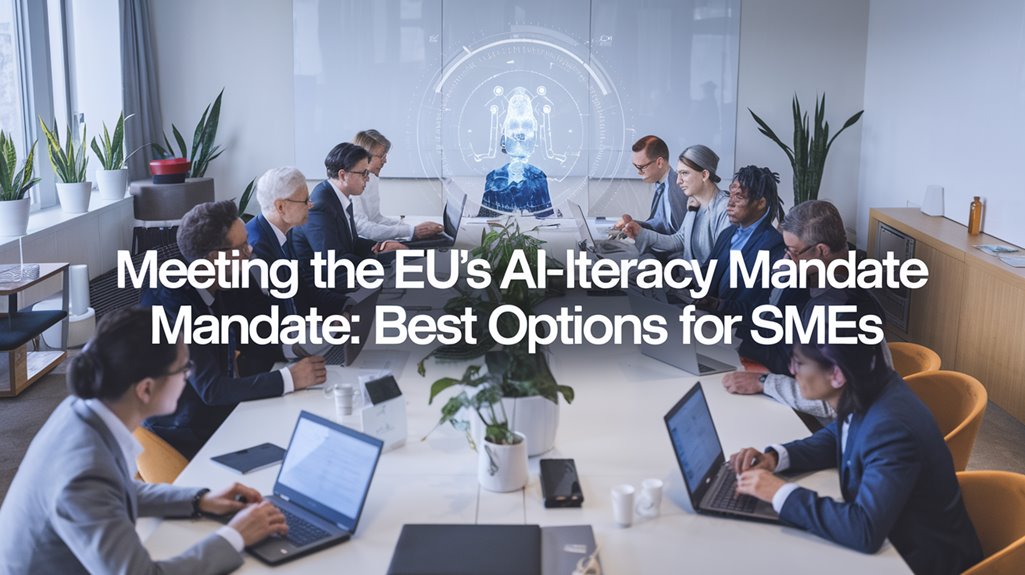Meeting the EU’s AI-Literacy Mandate: Best Options for SMEs
To meet the EU’s AI-literacy mandate, focus on developing tailored training programs that cater to various roles within your SME. Use diverse delivery methods, like online modules and peer learning, to engage staff at all levels. Integrate AI ethics training and risk management strategies to align with legal standards. Foster a learning culture to maintain AI literacy, and conduct regular skill assessments to refine training strategies. Discover how these initiatives guarantee compliance and strategic growth.
Understanding the EU AI-Literacy Requirement
With the EU AI Act’s deadline looming in February 2025, it’s vital for organizations to grasp the intricacies of the AI-literacy requirement.
The Act mandates that your organization guarantees staff and AI system users possess sufficient technical knowledge. Especially with high-risk AI, understanding AI’s functioning and associated risks is essential.
Article 4 emphasizes tailored training for different roles, from developers to end-users, to guarantee compliance. Non-compliance could result in fines up to €35 million or 7% of annual turnover, underscoring financial risks.
Proactively prepare by organizing company-wide meetings and interactive sessions. Cultivating a culture that supports AI discussions is strategic for embedding AI literacy, safeguarding against operational and reputational damage, and ultimately guaranteeing compliance.
Developing a Tailored AI Education Approach
As the EU AI Act emphasizes the importance of AI literacy, developing a tailored AI education approach becomes a strategic necessity for organizations aiming to meet compliance requirements.
It’s essential to align training with the specific roles and AI tools your employees use. Here’s how to enhance training effectiveness:
- Custom Learning Pathways: Cater to diverse knowledge levels by offering foundational understanding for newcomers and advanced modules for seasoned employees managing complex AI tasks.
- Industry-Specific Examples: Use relevant case studies to connect AI concepts with real-world applications, boosting engagement and comprehension.
- Varied Delivery Methods: Employ online modules, live sessions, and peer learning to address different learning preferences, promoting continuous AI education.
Regularly assess training effectiveness through metrics like completion rates and confidence levels to refine your strategy.
Integrating Ethical and Risk Awareness in Training
Recognizing the ethical and risk dimensions of AI is essential for ensuring responsible deployment within organizations. Embedding AI ethics and risk management into training programs helps you address biases and make informed decisions with AI technologies. Use case studies to illustrate ethical dilemmas and risk management strategies. Understanding legal implications, like the EU AI Act, is vital to avoid penalties. Regular updates in training materials keep you aligned with the latest in ethical AI, fostering continuous learning.
| Key Element | Description |
|---|---|
| AI Ethics | Recognize and address potential biases |
| Risk Management | Develop strategies to manage AI-related risks |
| Training Programs | Use case studies for practical understanding |
| Legal Implications | Comprehend EU AI Act obligations |
| Continuous Learning | Update skills with evolving AI ethics knowledge |
Engage in discussions to empower critical thinking and ethical AI use.
Fostering a Culture of Continuous AI Learning
Understanding the ethical and risk dimensions of AI is just the beginning. To truly foster a culture of continuous AI learning, you need to prioritize AI literacy through strategic initiatives.
Here’s how:
- Training Sessions: Regularly scheduled sessions with real-world examples and hands-on exercises boost employee engagement and AI skills, aligning with EU mandates.
- Peer Learning: Encourage informal gatherings like lunch and learns to facilitate knowledge-sharing across departments, promoting a collaborative learning atmosphere.
- Diverse Learning Channels: Offer online modules, instructor-led training, and gamified content to accommodate different learning preferences, ensuring broad participation.
Adopting these best practices helps SMEs not only comply with evolving regulations but also cultivate a workforce adept in AI skills, ready to meet future challenges.
Implementing Regular Skill Assessments and Diagnostics
When aiming to elevate AI literacy within your organization, implementing regular skill assessments and diagnostics becomes essential.
These tools help you identify current AI literacy levels among your staff, enabling you to tailor training programs effectively. By benchmarking AI proficiency, you can uncover specific areas needing improvement.
Focus assessments on foundational AI knowledge and role-specific applications to guarantee training relevance and effectiveness.
Employ a mix of quantitative metrics, like test scores, and qualitative feedback, such as employee satisfaction, to gain a thorough view of training effectiveness.
Continuous monitoring through regular skill assessments allows you to adapt your AI literacy strategies, ensuring alignment with evolving technologies and regulatory requirements.
Ultimately, this fosters a proficient and agile workforce ready to meet future challenges.
Leveraging AI Technologies Responsibly in SMEs
Elevating AI literacy through regular assessments naturally leads to the responsible application of AI technologies within SMEs.
To comply with the EU AI Act, prioritize AI literacy for your team. Here’s a strategic approach:
- Training Programs: Tailor your training programs for various roles to guarantee everyone understands ethical implications and risks associated with deploying AI. This helps in avoiding reputational damage and promotes informed decision-making.
- Internal AI Working Group: Establish a group to foster collaboration across departments, guaranteeing a thorough strategy for responsible AI usage.
- Continuous Learning Culture: Encourage a culture of curiosity and continuous learning to help your team navigate the evolving landscape of AI technologies, guaranteeing compliance and effective utilization.
Conclusion
To meet the EU’s AI-literacy mandate, focus on crafting a tailored AI education plan that aligns with your SME’s goals. Integrate ethical considerations and risk awareness into training, fostering a culture of continuous learning. Regularly assess skills to identify gaps and opportunities for growth. By leveraging AI technologies responsibly, you’ll not only comply with regulations but also gain a competitive edge. Stay proactive and strategic, ensuring your team is well-equipped to navigate the evolving AI landscape.
